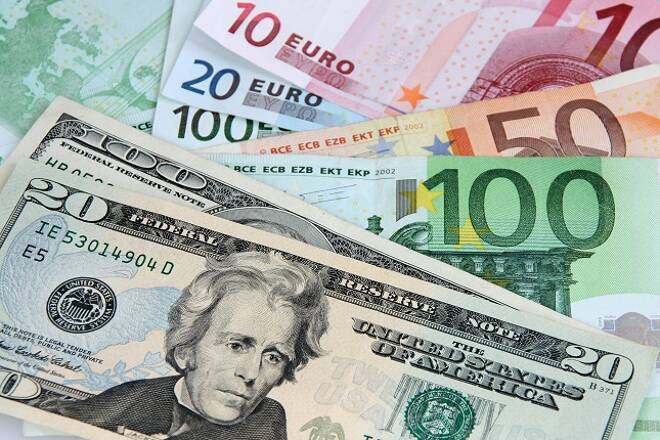Advertisement
Advertisement
EUR/USD Daily Technical Analysis for August 16, 2017
By:
The EUR/USD edged lower on Tuesday as stronger than expected U.S. retail sales and Empire State Manufacturing report helped buoy yields and boosted the
The EUR/USD edged lower on Tuesday as stronger than expected U.S. retail sales and Empire State Manufacturing report helped buoy yields and boosted the greenback. German GDP was in line with expectations, but Q1 was revised higher. The yield differential moved in favor of the U.S. dollar paving the way for a lower exchange rate.
Technicals
The EUR/USD moved lower but closed off its lows bouncing near the weekly lows at 1.1687. Resistance on the currency pair is seen near the 10-day moving average at 1.1792. Momentum remains negative as the MACD (moving average convergence divergence) histogram prints in the red with a downward sloping trajectory which points to a lower exchange rate. The relative strength index, which is a momentum oscillator that measures accelerating and decelerating momentum, has tumbled from overbought territory and reflects accelerating negative momentum.
Germany’s Top Court Calls on European Justice Court to check ECB’s QE program.
Germany’s Federal Constitutional Court has referred to the European Court of Justice for guidance in a lawsuit against the ECB. The German court wants the ECJ to clarify whether quantitative easing policy falls within the central bank’s mandate under the EU treaties. After the ECJ decision the case will go back to the German court. This is not the first challenge from Germany against the ECB asset purchase program and indeed there are five suits pending at the top court arguing that the German constitution permits the Bunesbank in participation in the program.
German GDP Was In Line with Expectations
German Q2 GDP rose 0.6% quarter over quarter below consensus, but with Q1 revised up to 0.7% quarter over quarter from 0.6%, which leaves a stronger overall trajectory. The annual rate rose to 2.1% year over year, the highest since 2014. There is no full breakdown with the preliminary number, but the stats office reported that private as well as government consumption improved markedly and that machinery as well as construction investment also picked up. Net exports meanwhile made a negative contribution as imports rose stronger than exports. The report was in line with expectations and confirming the robust German recovery, which judging by confidence data and the strong orders inflow in Q2 continues in the third quarter. The ECB has acknowledged the improved growth environment, but remains focused on low inflation and moderate wage growth and the most recent rise in the EUR will only add to the arguments for a very cautious approach to QE tapering.
Fed’s Consumer Expectations Inflation Where Steady
Fed’s July survey of consumer expectations showed steady views on prices, while expectations on household income growth hit a series high. The median inflation index from the Survey was unchanged at 2.5% for the 1-year time horizon, but slipped slightly in the 3-month time frame to 2.7% form 2.8%. Interestingly, the median “uncertainty” measure fell to a series low for the 1-year horizon at 2.2%, and dipped slightly to 2.6% for the 3-year horizon. Median 1-year home price change expectations declined for a third month, while expectations on gas price changes for the 1-year ahead declined for a third month too. Median 1-year expected earnings edged up 0.1% to 2.6%. And, median expected household income growth increased 0.3% to 3.0%, its highest level since the survey was started in June 2013. All this should be good news for the economy.
U.S. Empire Manufacturing Surged
U.S. Empire State manufacturing index surged 15.4 points to 25.2 in August, more than double than was expected, after dropping 10.0 points to 9.8 in July. This is the highest going back to September 2014. The employment component almost doubled to 6.2 from 3.9, while the workweek surged to 10.9 from unchanged. New orders climbed to 20.6 from 13.3. Prices paid rose to 31.0 from 21.3. Prices received were 6.2 from 11.0. The 6-month outlook rose to 45.2 from 34.9, with employment at 9.3 from 11.8.
Retail Sales Where Stronger than Expecgted
U.S. retail sales bounced 0.6% in July, with the ex-auto component rising 0.5%, both better than expected. Also, the 0.2% headline June decline was revised sharply higher to 0.3%, while the -0.1% May print is now unchanged. The June -0.2% ex-auto print was nudged up to 0.1%, while the -0.3% from May was bumped up to -0.2%. Sales excluding autos, gas and building materials climbed 0.5% from a 0.1% gain. Gains were rather broad-based. Motor vehicles and parts sales surged 1.2%, with building materials rising 1.2%. Miscellaneous sales bounced 1.8%. Non-store retailers climbed 1.3%. Furniture sales rose 0.4%. Gasoline station sales dipped 0.4%, with electronics off 0.5% and clothing down 0.2%.
About the Author
David Beckerauthor
David Becker focuses his attention on various consulting and portfolio management activities at Fortuity LLC, where he currently provides oversight for a multimillion-dollar portfolio consisting of commodities, debt, equities, real estate, and more.
Did you find this article useful?
Latest news and analysis
Advertisement
